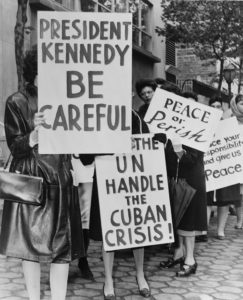By Isabel Martinez
 While many festivities celebrating Women’s History Month have been rightly canceled out of concern for the safety of our communities, we can still acknowledge and commend work that women have done to make this world a safer place. For generations, American women have fostered public support in an effort to reduce nuclear threats and eventually eliminate nuclear weapons. Indeed, it was American women who started a national movement that eventually helped push governments to create the first major arms control treaty of the nuclear age.
While many festivities celebrating Women’s History Month have been rightly canceled out of concern for the safety of our communities, we can still acknowledge and commend work that women have done to make this world a safer place. For generations, American women have fostered public support in an effort to reduce nuclear threats and eventually eliminate nuclear weapons. Indeed, it was American women who started a national movement that eventually helped push governments to create the first major arms control treaty of the nuclear age.
In the early years of the Cold War, many women must have felt that it was a battle being fought far away from their homes. By the late 1950s and early 1960s, they realized the effects of the U.S.-Soviet struggle was not only inside their homes, it was inside their children. The fall-out from explosive nuclear testing was spreading throughout the country and the world. American women decided that enough was enough. Of course at the time, women controlled few levers of power. By the end of the 1950s, women held just 19 seats in Congress. To make change, they had to organize and they had to make the matter personal.
In 1959, Members of the Greater St. Louis Citizens Committee for Nuclear Information, along with the schools of dentistry at Washington University in St. Louis and St. Louis University, gathered with the goal of demonstrating radioactive fallout from nuclear testing in Nevada was entering the food and milk supply in the area, significantly impacting children’s health. The project argued the effects could be seen in teeth, resulting in 320,000 baby teeth being collected over a 12-year period, and marking one of the first times the public mobilized in this capacity to aid scientific research.
At the same time, women like Bella Abzug and Dagmar Wilson founded and participated in Women Strike for Peace, a peace activist group with the goal of stopping nations from nuclear testing. On November 1, 1961 Women Strike for Peace brought 50,000 women in 60 different cities to the streets. This was the largest national women’s peace protest of the 20th century.
Wilson sent letters to the first lady, Jackie Kennedy, and the wife of the Soviet Premier, Nina Khrushchev, and received supportive letters in return. Coretta Scott King became involved in 1962, serving as a delegate for Women Strike for Peace in Geneva for a 17-nation disarmament conference, and upon her return stated, “We are on the brink of destroying ourselves through nuclear warfare.” These unprecedented actions did not go unnoticed by the U.S. government.
In 1962, Wilson and a few members of Women Strike for Peace were subpoenaed to testify before the House Un-American Activities Committee. The Committee, created in 1938 to investigate private citizens and organizations suspected of having Communist ties, believed WSP was being manipulated by malign forces. To protest these wild allegations, women packed the hearing with their children and baby bottles, and filled the aisle with strollers and flowers. Wilson and her colleagues “approached their testimony with irreverence, humor and creative resistance.” Newspaper headlines mocked the committee for their fruitless search, with one reading, “Peace Gals Make Red Hunters Look Silly.”
Following this, in 1963 the survey known as the Tooth Fairy study was released. It found children born in St. Louis in 1963 had 50 times as much strontium 90 (a radioactive chemical known to cause cancer) in their teeth as children born in 1950, before most atmospheric nuclear tests began. The project was an effective way of drawing national attention to the roughly 100 atmospheric tests conducted in Nevada.
Having been chastened by the near disaster of the Cuban Missile Crisis and in response to women-led public pressure campaign over explosive nuclear testing, the Soviet Union and United States, along with the United Kingdom, signed the Limited Nuclear Test-Ban Treaty (LTBT), prohibiting detonations of nuclear weapons underwater, in outer space, and in the atmosphere on August 5, 1963. The treaty entered into force on Oct. 10, 1963.
Following the enforcement of the LTBT, the Baby Tooth Survey ended in 1970. It conducted a second testing phase and “found a 50 percent decline in strontium 90 in children born in 1968, compared with those born five years earlier, immediately after the treaty went into effect.”
While American women helped end most explosive nuclear testing in several forms, the task is not complete. The Comprehensive Nuclear Test-Ban Treaty (CTBT), which bans nuclear explosions for any purpose anywhere in the world, opened for signatures in 1996, but is still waiting to enter into force. In order for the treaty to enter into force, eight more countries, including the United States, still must ratify the agreement. On the last day of Women’s History Month, perhaps it is time to do more than honor the past. Maybe it is time to emulate it.
